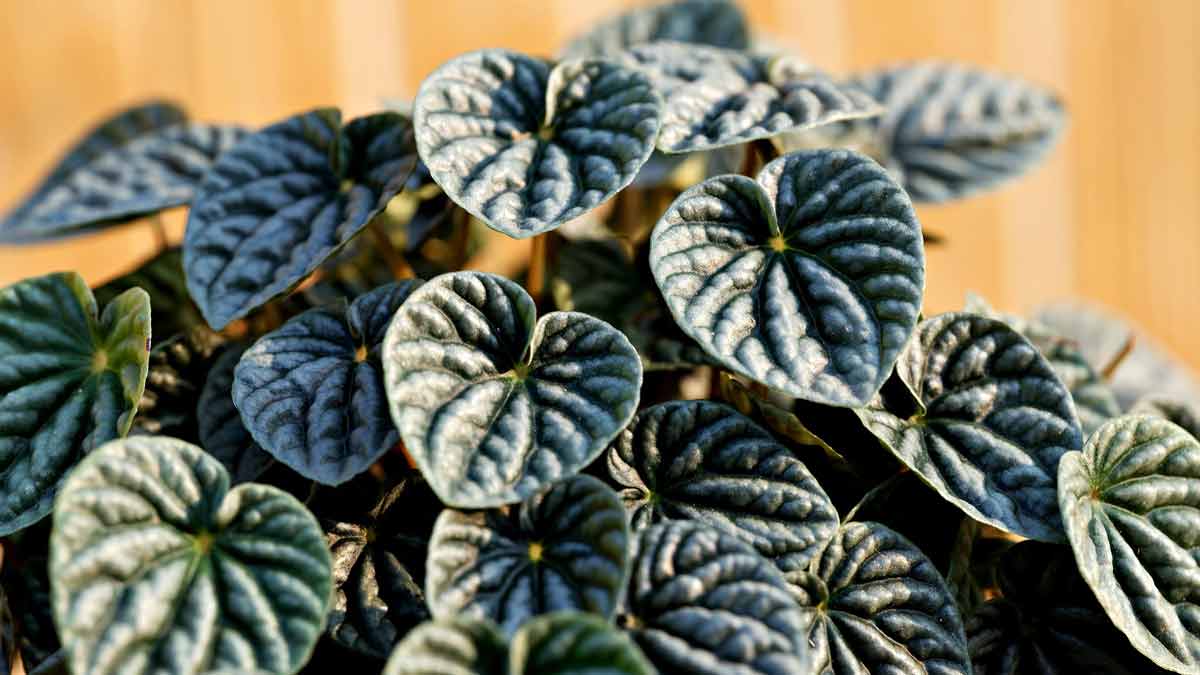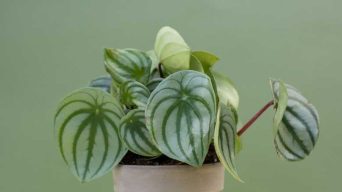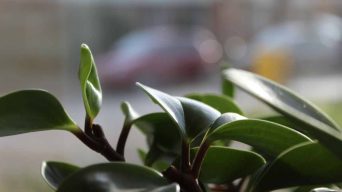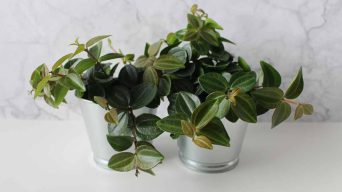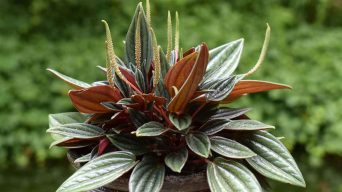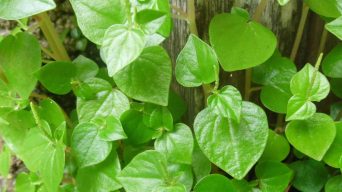Peperomia plants drop leaves due to overwatering, underwatering, poor light, soil quality, extreme temperatures, and improper fertilization. To prevent leaf drop, maintain moist soil, balance light and humidity, and avoid extreme conditions.
Peperomia plants are beautiful, easy-to-care-for houseplants that can brighten up any indoor space.
But what do you do when you notice that your peperomia’s leaves are falling off?
There are a few reasons why this may happen, but the good news is that you can also do a few things to fix the problem.
You need to take a closer look at your plant to determine the cause of why your peperomia is dropping leaves and then take the appropriate steps to remedy the situation.
This article will explain the most common reasons for peperomia leaves falling off and how you can fix the problem.
What Causes Peperomia Leaves To Fall Off
Peperomia leaves falling off can be caused by several different factors.
The most common reasons are:
1. Overwatering
Overwatering is the number one cause of peperomia dropping leaves.
Peperomias are sensitive to too much water and will start to drop their leaves if they are overwatered.
If you think your peperomia is being overwatered, you first should allow the top inch of soil to dry out completely before watering again.
To ensure your peperomia’s health, make sure to check the drainage holes regularly to ensure that they are not clogged and that the soil is not too wet, as this can lead to root rot and further leaf loss.
If you’re still seeing peperomia leaves dropping, try switching to a well-draining potting mix and watering only when the top inch of soil is dry.
Use a potting mix that is a combination of peat moss, perlite, and compost to ensure proper drainage; the perlite will help to aerate the soil and prevent it from becoming waterlogged, while the compost will provide essential nutrients.
2. Underwatering
Underwatering can also cause peperomia leaves to fall off.
Peperomias are drought-tolerant plants and can go long periods without water, but they will start to drop their leaves if they are not getting enough water.
If you think your peperomia plant is being underwatered, water it thoroughly, making sure that the water reaches the roots.
Water the peperomia plant thoroughly, making sure to saturate the soil all the way to the bottom of the pot so that the roots can absorb the moisture.
Then, allow the top inch of soil to dry out before watering again.
3. Temperature Stress
Peperomias are tropical plants and prefer warm, humid conditions.
They can tolerate some temperature fluctuations but may start to drop their leaves if they experience extreme temperature changes or if they are placed in a draught.
If you think your plant is experiencing temperature stress, try to keep it in a room between 65 and 80 degrees Fahrenheit with high humidity.
A great way to increase the humidity around your plant is to use a humidifier to add moisture to the air or place it on a pebble tray or group it with other plants to create a more humid environment.
4. Nutrient Deficiency
A nutrient deficiency can also cause peperomia leaves to fall off.
Peperomias need a well-balanced fertilizer containing all essential nutrients, including nitrogen, phosphorus, and potassium.
Salts, such as calcium and magnesium, are essential for healthy plant growth and can help to prevent nutrient deficiency, which can cause peperomia leaves to fall off by creating a more humid environment.
If you think your plant is not getting enough nutrients, fertilize it once a month during the growing season (spring and summer) with diluted all-purpose fertilizer.
5. Not Enough Light
Peperomias need bright, indirect light to thrive.
If they are not getting enough light, they will start to drop their leaves.
To fix this problem, move your plant to a brighter location.
The best location for a peperomia is one that gets bright, indirect light throughout the day.
An east- or west-facing window is a good option.
6. Too Much Sunlight
Too much sunlight can also cause peperomia plants to drop leaves.
Peperomias that are placed in direct sunlight will start to drop their leaves and may even get sunburned.
If you think your plant is getting too much sun, move it to a location that gets bright, indirect light instead.
7. Soil Issues
Soil that is too dense or too sandy can cause peperomia leaves to fall off.
Peperomias need a well-draining, loamy potting mix containing sand, silt, and clay.
If you think your plant’s soil is the problem, repot it in a well-draining potting soil mix, making sure to include a drainage hole at the bottom of the pot to allow excess water to escape.
8. Pests
Pests can also cause peperomia leaves to fall off.
Peperomias are susceptible to several pests, including aphids, mealybugs, and spider mites.
If you think your plant has bugs, inspect it carefully and look for small insects or webbing.
You can remove pests from your plant by spraying it with water or using a cotton swab dipped in rubbing alcohol.
You can also treat the plant with an insecticidal soap or neem oil to get rid of the pests.
9. Diseases
Diseases can also cause peperomia leaves to fall off.
Peperomias are susceptible to several diseases, including root rot and fungal leaf spot.
If you think your plant has a disease, inspect it carefully and look for signs of infection, such as discolored leaves or stems.
You can treat most diseases with a fungicide or bactericide.
10. Transplant Shock
When a Peperomia is dropping leaves, it can be the result of transplant shock.
Peperomias are sensitive to environmental changes and can undergo transplant shock when moved to a new location.
If you suspect your plant is experiencing transplant shock, it’s important to give it time to adjust to its new environment.
Ensure the plant is placed in a location that receives bright indirect sunlight and maintains the proper temperature and humidity.
Avoid overwatering the plant or fertilizing it until it has fully adapted to its new surroundings
11. Natural Leaf Shedding
Finally, it’s important to note that some peperomias will naturally shed their leaves as they age.
If your plant is shedding its leaves and you can’t find any other explanation, it’s probably just natural leaf shedding.
There’s nothing you can do to prevent this from happening.
Just make sure the plant is healthy and has the proper growing conditions.
What To Do When Your Peperomia Begins Dropping Leaves
If your peperomia leaves are dropping, there are a few things you can do to fix the problem.
First, try to identify the cause of the problem.
Once the cause of the problem has been identified, a possible solution could be to implement a plan of action that addresses the issue and provides a long-term solution.
Here are a few things you can do when your peperomia leaves start falling off:
1. Keep Your Plant Healthy
Keeping your plant healthy is the best way to prevent peperomia leaf dropping.
Ensure the plant has the proper growing conditions and gets enough light, water, and nutrients.
You should also inspect your plant regularly for pests and diseases.
2. Prune Off Dead Leaves
If your Peperomia plant leaves are starting to turn yellow or brown, you can prune them off to improve the plant’s appearance.
Use sharp scissors or pruning shears to cut off the dead leaves at the base of the plant.
3. Repot The Plant
If you think your plant’s soil is the problem, you can try repotting it.
Choose a well-draining potting mix and a pot slightly larger than the plant.
Carefully remove the plant from its pot and replant it in the new potting mix.
Once the new potting mix is in the pot, sprinkle a layer of pebbles on top to help with drainage and provide a decorative touch to the pot.
4. Treat The Plant For Pests
If you think your plant has pests, you can try treating it with insecticidal soap or neem oil.
You can also try spraying the plant with water or using a cotton swab dipped in rubbing alcohol to remove the pests.
5. Treat The Plant For Diseases
You must remove the infected leaves if you think your plant has a disease.
If you think your plant has a disease, you should first assess its condition and determine if it is a fungal or bacterial infection before treating it with a fungicide or bactericide.
A great natural option is to use a milk and water mixture.
Mix 1 part milk with 9 parts water and spray the plant with the mixture.
The damage caused by pests and diseases can be reduced by spraying the plant with a mixture of 1 part milk and 9 parts water, which can help prevent further damage to the plant.
6. Give The Plant Time To Adjust
If you think your plant is experiencing transplant shock, you must give it time to adjust to its new environment.
Ensure the plant is in a location that gets bright indirect light and has the proper temperature and humidity.
Do not overwater the plant or fertilize it until it has adjusted to its new environment.
7. Don’t Worry, It’s Natural
Finally, if your plant is shedding its leaves and you can’t find any other explanation, don’t worry.
It’s probably just natural leaf shedding.
There’s nothing you can do to prevent this from happening.
Just make sure the plant is healthy and has the proper growing conditions.
The Advantages Of Peperomia Leaf Shedding
Peperomia leaf drop can be a good thing for your plant.
Leaf shedding helps the plant get rid of old, damaged, or diseased leaves.
This allows the plant to focus its energy on new growth.
Leaf drop also helps the plant regulate its temperature and conserve water.
So, don’t be too concerned if your peperomia leaves are dropping off.
As long as the plant is healthy and has the proper growing conditions, peperomia leaf shedding is nothing to worry about.
What To Do With Fallen Peperomia Leaves
If you find peperomia leaves that have fallen off your plant, you can compost them.
Before adding them to your compost pile, ensure the leaves are free of pests and diseases.
You can also use the leaves to propagate new plants.
To propagate peperomia plants from fallen leaves, follow these steps:
- Cut a fallen leaf into two pieces, ensuring each piece has a bit of stem attached.
- Place the leaf pieces in a pot filled with moist, well-draining potting mix.
- Cover the pot with plastic wrap or a glass jar and place it in a warm, bright spot.
- Keep the soil moist but not wet, and wait for the leaves to root.
- Once the roots have grown, you can remove the plastic wrap or glass jar and water the plants as needed.
- When the plants are large enough, you can transplant them into individual pots.
Final Thoughts
As a houseplant enthusiast, I understand the significance of providing proper care and attention to your peperomia. This ensures you can minimize leaf loss and aid it in returning to a healthy state.
Make sure to invest time in researching the best practices for caring for your houseplant, ensuring it receives the right environment, nutrients, and hydration it needs to thrive.
If your peperomia leaves are falling off, it is most likely due to one of the issues discussed above.
Inspect your plant carefully and correct the problems as soon as possible to avoid further leaf loss.
With proper care and attention, your succulent peperomia should soon be thriving again, as it is an incredibly resilient plant that can easily bounce back from leaf loss with the right environment and nutrition.

